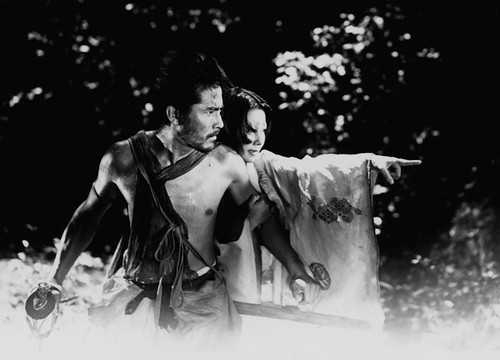Three of the characters in Ghost Dog appear to be innocent by-standers, although only one is completely innocent in many respects.
In this regard, we have the mob boss' daughter and Ghost Dog's 2 friends, a young girl named Pearline and Ghost Dog's best friend, Raymond, a french-speaking Haitian ice cream vendor who sells his treats at the park where Ghost Dog also meets with Pearline.
The mob boss' daughter first meets Ghost Dog when he assassinates the gangster with whom she is having an affair. Ghost Dog does not kill her, though she is a witness to the murder. She hands him a copy of Rashomon, the short story version. This seems to indicate some kind of "passing down" to Ghost Dog a task. At least that's what it appears to be, because though he lets her live, he eventually wipes out most of her mafia family and she, consequently, takes over the family business. She, unwittingly or not, causes the strange turn of events that puts Ghost Dog on the path of war against her crime family.
Pearline is a young girl with whom Ghost Dog trades books, including the copy of Rashomon given to Ghost Dog by the mob boss' daughter. At the end of the movie, we see Ghost Dog hand over his Samurai manual, the Hagakure, to Pearline as he takes back the copy of Rashomon as he meets his death by Louie's bullets; Ghost Dog allows Louie to kill him and hands him Rashomon. Louie then goes to a limo where his new boss, the mob boss' daughter is waiting for him.
As Ghost Dog lies dead in the park, Pearline picks up his gun and takes aim, indicating that she takes over Ghost Dog's tradition just as the mob boss' daughter takes over her father's tradition. This provides an excellent juxtaposition, showing 2 seemingly innocent young girls taking the reins of the violent endeavors of their predecessors.
Of note in this regard, is a scene in which a mafia henchman kills a female state trooper and asserts that it is a statement of equality to do so, while his partner is horrified that he shot a woman; again, showing two varying perspectives on a single incident, and a bit of an indictment of misguided single issue politics. That one scene could take up an article in itself to analyze as far as its meaning goes. I won't get into it here.
These divergent views of tradition are repeated in the movie, of particular note are the views within the mafia family itself; older members have very backward and racist views related to Ghost Dog, while others are more progressive and even show an enthusiasm for Hip Hop music (which is used in brilliant ways throughout the movie). Even more telling is a scene in which 2 mafia hit-men are searching for Ghost Dog and run into a Native-American who they are unable to clearly distinguish between Ghost Dog who has only been described to them as black and that he keeps pigeons on a roof-top. They don't know what to do, so they kill one of the Native's pigeons. This is an obvious statement about the absurdity of racism and race relations and also reveals the Native's own feelings on the matter as he calls the 2 men "stupid ** white man". This, of course, has many sociopolitical implications which, again, would require much discussion which I won't get into here.
Finally, there is a scene in which Ghost Dog approaches 2 racist bear hunters because he sees that they've killed a black bear. The metaphor of the bear is important in the story as Raymond refers to Ghost Dog as a bear, because bears only attack if provoked or feel they are in danger. The hunters tell Ghost Dog that they like to kill black bears because "there aren't many of these black ** left." When Ghost Dog questions them a bit on their activity and rationale, they say that "there aren't many colored folks around here either" and attempt to shoot Ghost Dog; Ghost Dog, of course, skillfully defends himself; just before killing off the hunters, he tells them that in ancient cultures bears were considered equal with men; the hunter says, "this aint no ancient culture here, mister", to which Ghost Dog replies, "sometimes it is" and kills the hunter. This shows 2 different perspectives: Ghost Dog's ancient system of honor and the hunters' rather flippant disregard and callous orientation.
In the end, Raymond is the most innocent of all the characters and seems to represent that part of society that cares and is outside of the traditions that are marred by violence and divisiveness (What tradition is not?). He is heart-broken when he witnesses the assassination of Ghost Dog in the park.
It should be said, too, that a demarcation between the Mafia perspective and Ghost Dog's Samurai tradition are clear in the movie too. The Mafia is operating in the interest of business and family, and avoiding getting in trouble with the law, and Ghost Dog operates primarily by honor and loyalty but also certainly for survival. Self-interest on some level is a motivation for most of the characters in the movie.
Interspersed in the movie are various scenes in which elements of the ghetto are introduced, including a brief meeting between Ghost Dog and another honorable resident of the hood (played by Hip Hop artist RZA, who also provided the score for the movie). The environment is repeatedly compared and contrasted with Ghost Dog's condition; Ghost Dog being a product of the ghetto but also so drastically different from everyone else there.
Of note, too, is the recurrence of the presence of a dog that comes along periodically to stare at Ghost Dog. Possibly this is Ghost Dog's conscience.









 Why Are My Veins So Visible?on 07/15/2020
Why Are My Veins So Visible?on 07/15/2020
 Should Female Backpackers Go on their Own? Why or Why Not?on 07/15/2020
Should Female Backpackers Go on their Own? Why or Why Not?on 07/15/2020
 Why Do BPD Women Lie?on 07/15/2020
Why Do BPD Women Lie?on 07/15/2020
 Why Do My Joints Hurt?on 07/15/2020
Why Do My Joints Hurt?on 07/15/2020



Comments